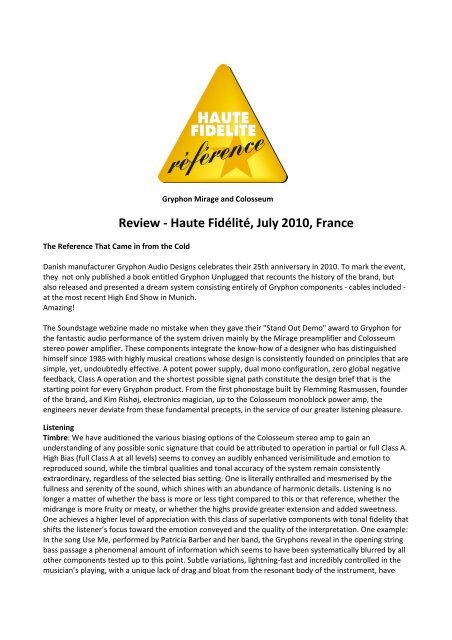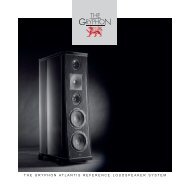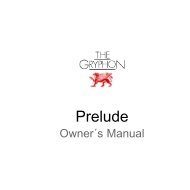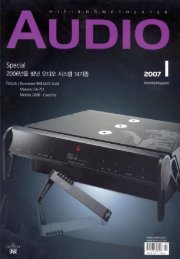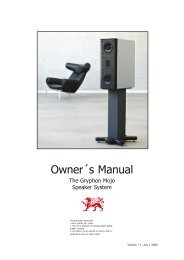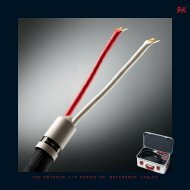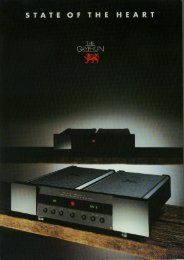Review by Haute Fidélité Products: Mirage & Colosseum Country
Review by Haute Fidélité Products: Mirage & Colosseum Country
Review by Haute Fidélité Products: Mirage & Colosseum Country
You also want an ePaper? Increase the reach of your titles
YUMPU automatically turns print PDFs into web optimized ePapers that Google loves.
The Reference That Came in from the Cold<br />
Gryphon <strong>Mirage</strong> and <strong>Colosseum</strong><br />
<strong>Review</strong> ‐ <strong>Haute</strong> <strong>Fidélité</strong>, July 2010, France<br />
Danish manufacturer Gryphon Audio Designs celebrates their 25th anniversary in 2010. To mark the event,<br />
they not only published a book entitled Gryphon Unplugged that recounts the history of the brand, but<br />
also released and presented a dream system consisting entirely of Gryphon components ‐ cables included ‐<br />
at the most recent High End Show in Munich.<br />
Amazing!<br />
The Soundstage webzine made no mistake when they gave their "Stand Out Demo" award to Gryphon for<br />
the fantastic audio performance of the system driven mainly <strong>by</strong> the <strong>Mirage</strong> preamplifier and <strong>Colosseum</strong><br />
stereo power amplifier. These components integrate the know‐how of a designer who has distinguished<br />
himself since 1985 with highly musical creations whose design is consistently founded on principles that are<br />
simple, yet, undoubtedly effective. A potent power supply, dual mono configuration, zero global negative<br />
feedback, Class A operation and the shortest possible signal path constitute the design brief that is the<br />
starting point for every Gryphon product. From the first phonostage built <strong>by</strong> Flemming Rasmussen, founder<br />
of the brand, and Kim Rishøj, electronics magician, up to the <strong>Colosseum</strong> monoblock power amp, the<br />
engineers never deviate from these fundamental precepts, in the service of our greater listening pleasure.<br />
Listening<br />
Timbre: We have auditioned the various biasing options of the <strong>Colosseum</strong> stereo amp to gain an<br />
understanding of any possible sonic signature that could be attributed to operation in partial or full Class A.<br />
High Bias (full Class A at all levels) seems to convey an audibly enhanced verisimilitude and emotion to<br />
reproduced sound, while the timbral qualities and tonal accuracy of the system remain consistently<br />
extraordinary, regardless of the selected bias setting. One is literally enthralled and mesmerised <strong>by</strong> the<br />
fullness and serenity of the sound, which shines with an abundance of harmonic details. Listening is no<br />
longer a matter of whether the bass is more or less tight compared to this or that reference, whether the<br />
midrange is more fruity or meaty, or whether the highs provide greater extension and added sweetness.<br />
One achieves a higher level of appreciation with this class of superlative components with tonal fidelity that<br />
shifts the listener’s focus toward the emotion conveyed and the quality of the interpretation. One example:<br />
In the song Use Me, performed <strong>by</strong> Patricia Barber and her band, the Gryphons reveal in the opening string<br />
bass passage a phenomenal amount of information which seems to have been systematically blurred <strong>by</strong> all<br />
other components tested up to this point. Subtle variations, lightning‐fast and incredibly controlled in the<br />
musician’s playing, with a unique lack of drag and bloat from the resonant body of the instrument, have
never been so clearly perceived. Consequently, they emphasise the intensity of the performance. Shifts in<br />
tonal register as the bassist thumbs the strings of the instrument, are incredibly precise and laden with<br />
micro‐detail. The realism is at its peak.<br />
Dynamics: The specifications provided <strong>by</strong> the manufacturer and the technical details of the amplifier in<br />
terms of power supply filtering and available instantaneous current are dizzying, as is the theoretical<br />
performance of the preamplifier in terms of gain and bandwidth. Therefore, we expected a constant<br />
dynamic emphasis imparting some exaggerated brilliance and demonstrativeness. But what we<br />
experienced was simply quite the opposite. The Gryphons are significantly ahead of the competition with<br />
regard to the precision with which they provide the required amount of instantaneous energy on demand.<br />
Certainly, when it comes to sending Watts to drive transients (bass drum kicks or powerful piano passages),<br />
the listener is well served. Output levels do not suffer from saturation effects or from compression – It<br />
pushes when it is supposed to push. And the timing between the ultra‐fast attack of notes, the amply<br />
documented wealth of detail and the decay that is never muzzled or softened completes the credible sonic<br />
illusion. In the same spirit, during the subtlest pianissimo passages, the Gryphons scrutinize the audio signal<br />
in depth in order to extract the slightest inflection, the most inaudible of micro‐details and the most distant<br />
ambience of the recording space. Thanks to their fully optimised circuits, all steps are taken to preserve the<br />
texture of the musical content. All this contributes to the impression of an analytical precision that is<br />
subjectively superior, with abiding, majestic handling of any style of music.<br />
Soundstage: The analytical capabilities of these Danish components are stunning, demanding a comparable<br />
level of performance and neutrality from the remaining links in the audio chain. Under these conditions and<br />
after optimisation of the system (cables, placement in the room), the soundstage surpasses what one has<br />
become accustomed to. It presents itself as a remarkable spaciousness, a refreshing airiness and a sonic<br />
solidity with a fullness that could be taken for Blu‐ray audio. The foundation established <strong>by</strong> the sublime,<br />
supremely well‐articulated deep bass provides a sense of an unswervingly stable stereo image, laid out<br />
generously and unconstrained before the listener. The wealth of reproduced detail creates an astounding<br />
spatial illusion. One has the feeling that the virtual dimensions of the recorded space have been<br />
augmented, notably in the depth dimension, an area in which most components seem to be<br />
uncomfortable. The layering of elements in Samedi soir sur la Terre <strong>by</strong> Francis Cabrel is extremely precise. It<br />
is as if you can distinguish the position of each music stand in the recording studio, more spacious than one<br />
is accustomed to. The choir singing the score of Dies Irae (Mozart’s Requiem) has simultaneously gained in<br />
level and in physical volume; the singers are spread out across a larger area.<br />
Transparency: The criterion of transparency takes on new meaning with components like the <strong>Mirage</strong><br />
preamp and <strong>Colosseum</strong> stereo amp. Once again, they express themselves fully in a system when partnered<br />
with of products of equal quality. There is not a lot to add that hasn’t already been mentioned in the<br />
preceding listening notes. They are capable of handling all musical genres with alacrity of execution, lasting<br />
clarity and total neutrality. The designer has not skimped and every area benefits. The Gryphons appear to<br />
redefine such terms as “articulation” and “punch” in the deep bass and extreme bass to such an extent that<br />
they have rarely been reproduced with such tonality and immediacy. The general timbral quality in terms of<br />
the accuracy of tonal reproduction scales new heights, each recording rendered with its own specific range<br />
of colours. The great subtlety of the highs combines with agility, acuity and body rarely found<br />
simultaneously in transistor components at any level.<br />
Conclusion<br />
As usual, the Danish designer has not skimped on the concept and build quality of the two electronic jewels<br />
dubbed the <strong>Mirage</strong> preamplifier and <strong>Colosseum</strong> power amplifier. Frankly, we had been quite taken with the<br />
sonic performance of their integrated Diablo. It appears that the envelope has been pushed much further<br />
back with the <strong>Mirage</strong>/<strong>Colosseum</strong> pairing, which deserves to be regarded as a sonic reference that will go
down in the history of high fidelity. The exclusive build and pedigree of each component are combined with<br />
perfectly optimised technical solutions mastered <strong>by</strong> the makers. The breathtaking performance manifests<br />
itself to the listener as a neutral rendering, subtle and captivating, yet capable of expanding from a whisper<br />
to a blast of notes at the slightest prompting. The radical cosmetic aesthetics add a touch of elite distinction<br />
essential in products of total sonic transparency. Stunning.<br />
Build: 5/5<br />
Timbre: 5/5<br />
Dynamics: 5/5<br />
Imaging: 5/5<br />
Transparency: 5/5<br />
Quality/Price: Irrelevant<br />
New magazine Reference


